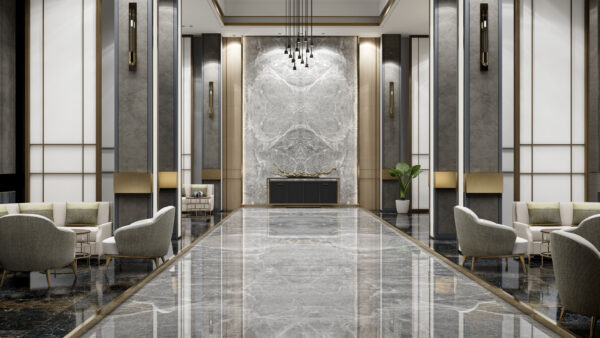Persian silk marble
Marbles are among the most diverse building stones in Iran. Meanwhile, Persian Silk marble has a special place, especially among architects and building company. Persian Silk is a combination of two words Persian meaning Iranian and Silk meaning silk, which actually refers to its texture and irregular lines. Persian silk marble with light to dark gray color is extracted from the quarries of Fars, Yazd and Isfahan provinces. The quarries located in Niriz city of Fars province includes three quarries, Bayat, Hashemi, and Rahmandoost, and the stones extracted from Bayat quarry are of higher quality than the others.
Persian Silk marble quarry in Isfahan is also located in Joshghan city. This stone is very popular among architects and designers due to its uniform background and great color play, and it is considered as one of materials for export, so it is mostly exported in the form of blocks. This stone is relatively rare in the domestic market; For this reason, it is processed in a limited and specific way. Persian Silk marble is also known as Silk Emperador stone.
Iran’s main luck is in having rare stones such as pink onyx. Onyx owes its pink color to the presence of manganese. The higher the amount of manganese; The color of the stone is also darker. A stone whose attractive color has been very attractive to the past. Iranian Pink onyx has been very popular with its distinctive color and striking black veins.
This stone can be used in many structures. This stone has quarry in many countries in the world; And after polishing the stone, they use it in structures and other cases.

Appearance and texture characteristics of
One of the special features of Persian Silk marble is its relatively uniform background. The background of this stone can be seen in light to dark gray color and streaks pass through it. The size of these veins is large and sometimes it can be seen in a wavy form. Persian Silk marble is actually a gray limestone that has a dense texture. These types of limestones are formed in semi-deep to deep areas of the open seas, and there are various reasons for the gray color in them, including the presence of iron sulfide in the chemical composition of the stone.
The formation of stone in the deep areas of the seas makes the sedimentation process to be relatively calm, which is clearly seen in the uniform texture of Persian Silk marble. Also, the main factor in the high density and low porosity of Persian Silk marble is sedimentation in the calm and deep sea environment. The more turbulent the stone deposition environment is, the less uniform the stone background will be. The veins in the texture of this stone are large, which is why if this stone is cut into slabs and processed, the veins show their beauty well.
The large veins are also a reason for the relatively high density and resistance of Persian Silk marble. Most of the veins in the background texture of the stone are caused by tectonic activities such as: the activity of active faults in the region; The aforementioned tectonic fractures are gradually filled by secondary materials (calcite, silica or clay) and are seen as streaks.
It should be noted that some varieties of Persian Silk marble have similarities with Dehbid, Khoi and Bastam stones, with the difference that the background of Persian Silk stone is darker and more uniform.
Also, there may be fossil fragments in the texture of Persian Silk stone; The lower the number of these pieces in the stone, the higher its price will be because the presence of these fossil pieces in the context of the background of Persian Silk marble reduces the uniformity of the background.

Applications of Persian Silk marble
- Interior design of the building
- Tiles for floor
- Steps and walls
- Kitchen area and counter top
- Elevator frame
- wet rooms

© Copyright 2023 M.STONE TRADING


